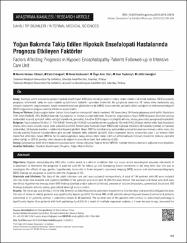| dc.contributor.author | Helvacı Yılmaz, Nesrin | |
| dc.contributor.author | Erdoğan, Cem | |
| dc.contributor.author | Kızılaslan, Deniz | |
| dc.contributor.author | Arıcı Düz, Özge | |
| dc.contributor.author | Hanoğlu, Lütfü | |
| dc.contributor.author | Toplutaş, Eren | |
| dc.date.accessioned | 2019-12-31T12:11:12Z | |
| dc.date.available | 2019-12-31T12:11:12Z | |
| dc.date.issued | 2019 | en_US |
| dc.identifier.citation | Helvacı Yılmaz, N., Erdoğan, C., Kızılaslan, D., Arıcı Düz, Ö., Toplutaş, E. ve Hanoğlu, L. (2019). Yoğun bakımda takip edilen hipoksik ensefalopati hastalarında prognozu etkileyen faktörler. Ankara Üniversitesi Tıp Fakültesi Mecmuası, 72(2), 199-204. https://doi.org/ 10.4274/atfm.galenos.2018.2019.16878 | en_US |
| dc.identifier.issn | 0365-8104 | |
| dc.identifier.uri | https://doi.org/ 10.4274/atfm.galenos.2018.2019.16878 | |
| dc.identifier.uri | https://hdl.handle.net/20.500.12511/4841 | |
| dc.description.abstract | Öz:Amaç: Kardiyak arrest sonrasında gelişen hipoksik ensefalopati (HE) ciddi nörolojik sekel ve ölüme neden olabilen bir klinik tablodur. HE’li hastalarda prognozu belirlemek, takip ve uzun vadede geliştirilecek tedaviler açısından önemlidir. Bu çalışmada amacımız HE tanısı almış hastalarda yaş, cinsiyet, hipotermi uygulamasının, beyin manyetik rezonans görüntüleme de (MRG) lezyon yerinin, epileptik nöbet varlığının ve elektroensefalografi (EEG) bulgularının prognoz üzerine etkilerini araştırmaktır. Gereç ve Yöntem: Erişkin yoğun bakım ünitesi hasta kayıtları retrospektif olarak incelendi. HE tanısı almış 194 hasta çalışmaya dahil edildi. Hastaların 118’i erkek (%60,8), 76’sı (%39,2) kadındı. Sağ kalanlar ve eksitus olanlar belirlendi. Hipotermi uygulananlar, beyin MRG bulguları (kortikal ve/veya subkortikal lezyon), epileptik nöbet varlığı (miyoklonik, jeneralize, fokal) ve EEG bulguları (epileptik aktivite, status, jeneralize yavaşlama) kaydedildi. Bulgular: Yaş ortalaması 59,46±1,71 (18-89) idi. Yetmiş altı (%39,2) hastaya hipotermi uygulandı. Yüz yedi (%55,2) hasta eksitus oldu. Yaşlı hastaların eksitus olma oranı anlamlı olarak daha yüksekti (p<0,01). Seksen sekiz hastanın beyin MRG’sinde hipoksik etkilenme (8 hastada kortikal, 21 hastada subkortikal, 59 hastada kortikal + subkortikal lezyon) görüldü. Beyin MRG’de kortikal veya subkortikal patoloji bulunanların taburcu olma oranı, her ikisinde patoloji bulunan hastalarınkine göre anlamlı düzeyde daha yüksekti (p<0,01). Çoklu regresyon analizi sonucunda yaşın 1 yıl artması ölüm riskini %4 arttırırken, beyin MRG’de her iki alanda patolojik bulgu olması ölüm riskini 2,62 kat arttırmaktaydı. Cinsiyet, hipotermi tedavisi, epileptik nöbet varlığı ve EEG’de patoloji olma durumu ile sağkalım arasında anlamlı fark yoktu (p>0,05). Sonuç: Çalışmamıza dahil edilen hastaların yaklaşık yarısı eksitus olmuştur. Yaşlı ve beyin MRG’de multiple lezyonu olanların sağkalım oranı düşüktür. | en_US |
| dc.description.abstract | Objectives: Hypoxic encephalopathy (HE) after cardiac arrest is a clinical condition that can cause severe neurological sequelae and death. It is important to determine the prognosis in patients with HE for follow up and developing future treatments in the long term. Our aim was to investigate the effects of age, gender, hypothermia, lesion site in brain magnetic resonance imaging (MRI), seizure and electroencephalography (EEG) findings on prognosis in patients with the diagnosis of HE. Materials and Methods: The data of the adult intensive care unit was evaluated retrospectively. A total of 194 patients with HE were included into the study. One hundred and eighteen (60.8%) of the patients were male and 76 (39.2%) were female. The survivors and those who died were identified. Hypothermia therapy, brain MRI findings (cortical and/or subcortical lesion), presence of seizures (myoclonic, generalized, focal) and EEG findings (epileptic activity, status, generalized slowing) were recorded. Results: The mean age was 59.46±1.71 (18-89). Seventy-six (39.2%) patients underwent hypothermia. One hundred and seven (55.2%) patients died. The rate of exitus in elderly patients was significantly higher (p<0.01). The brain MRI of 88 patients showed hypoxic lesions (cortical in 8 patients, subcortical in 21 patients, cortical + subcortical lesion in 59 patients). The survival rate of the patients with cortical or subcortical pathology is significantly higher than patients with both pathology (p<0.01). As a result of multiple regression analysis, a 1-year increase in age, increased the risk of death by 4%, while the presence of pathological findings in both areas in brain MRI increased the risk of death by 2.62 times. There was no significant difference of gender, hypothermia, seizures and pathological EEG findings on survival (p>0.05). Conclusion: Approximately half of the patients included in our study died. The survival rate of the elderly patients and the patients with multiple lesions in brain MRI was low | en_US |
| dc.language.iso | tur | en_US |
| dc.publisher | Galenos Yayıncılık | en_US |
| dc.rights | info:eu-repo/semantics/openAccess | en_US |
| dc.rights | Attribution-NonCommercial-NoDerivatives 4.0 International | * |
| dc.rights | https://creativecommons.org/licenses/by-nc-nd/4.0/ | * |
| dc.subject | Hipoksik Ensefalopati | en_US |
| dc.subject | Prognoz | en_US |
| dc.subject | Yoğun Bakım Ünitesi | en_US |
| dc.subject | Hypoxic Encephalopathy | en_US |
| dc.subject | Prognosis | en_US |
| dc.subject | Intensive Care Unit | en_US |
| dc.title | Yoğun bakımda takip edilen Hipoksik Ensefalopati hastalarında prognozu etkileyen faktörler | en_US |
| dc.title.alternative | Factors affecting prognosis in Hypoxic Encephalopathy patients followed-up in intensive care unit | en_US |
| dc.type | article | en_US |
| dc.relation.ispartof | Ankara Üniversitesi Tıp Fakültesi Mecmuası | en_US |
| dc.department | İstanbul Medipol Üniversitesi, Tıp Fakültesi, Dahili Tıp Bilimleri Bölümü, Nöroloji Ana Bilim Dalı | en_US |
| dc.department | İstanbul Medipol Üniversitesi, Tıp Fakültesi, Cerrahi Tıp Bilimleri Bölümü, Anesteziyoloji ve Reanimasyon Ana Bilim Dalı | en_US |
| dc.authorid | 0000-0001-7566-1063 | en_US |
| dc.authorid | 0000-0002-5715-8138 | en_US |
| dc.authorid | 0000-0001-6587-8103 | en_US |
| dc.authorid | 0000-0003-0334-811X | en_US |
| dc.authorid | 0000-0003-4292-5717 | en_US |
| dc.authorid | 0000-0001-6365-7702 | en_US |
| dc.identifier.volume | 72 | en_US |
| dc.identifier.issue | 2 | en_US |
| dc.identifier.startpage | 199 | en_US |
| dc.identifier.endpage | 204 | en_US |
| dc.relation.publicationcategory | Makale - Ulusal Hakemli Dergi - Kurum Öğretim Elemanı | en_US |
| dc.identifier.doi | 10.4274/atfm.galenos.2018.2019.16878 | en_US |


















